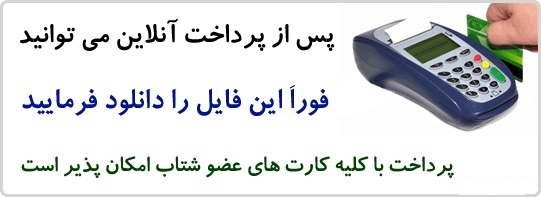لینک دانلود و خرید پایین توضیحات
فرمت فایل word و قابل ویرایش و پرینت
تعداد صفحات: 11
Project Management
Project Management is the discipline of planning, organizing, and managing resources to bring about the successful completion of specific project goals and objectives. A project is a finite endeavor—having specific start and completion dates—undertaken to create a unique product or service which brings about beneficial change or added value. This finite characteristic of projects stands in sharp contrast to processes, or operations, which are permanent or semi-permanent functional work to repetitively produce the same product or service. In practice, the management of these two systems is often found to be quite different, and as such requires the development of distinct technical skills and the adoption of separate management philosophy, which is the subject of this article.
The primary challenge of project management is to achieve all of the project goals and objectives while adhering to classic project constraints—usually scope, quality, time and budget. The secondary—and more ambitious—challenge is to optimize the allocation and integration of inputs necessary to meet pre-defined objectives. A project is a carefully defined set of activities that use resources (money, people, materials, energy, space, provisions, communication, motivation, etc.) to achieve the project goals and objectives.
History of project management
As a discipline, project management developed from different fields of application including construction, engineering, and defense. In the United States, the forefather of project management is Henry Gantt, called the father of planning and control techniques, who is famously known for his use of the Gantt chart as a project management tool, for being an associate of Frederick Winslow Taylor's theories of scientific management[1], and for his study of the work and management of Navy ship building. His work is the forerunner to many modern project management tools including the work breakdown structure (WBS) and resource allocation.
The 1950s marked the beginning of the modern project management era. Again, in the United States, prior to the 1950s, projects were managed on an ad hoc basis using mostly Gantt Charts, and informal techniques and tools. At that time, two mathematical project scheduling models were developed: (1) the "Program Evaluation and Review Technique" or PERT, developed by Booz-Allen & Hamilton as part of the United States Navy's (in conjunction with the Lockheed Corporation) Polaris missile submarine program[2]; and (2) the "Critical Path Method" (CPM) developed in a joint venture by both DuPont Corporation and Remington Rand Corporation for managing plant maintenance projects. These mathematical techniques quickly spread into many private enterprises.
At the same time, technology for project cost estimating, cost management, and engineering economics was evolving, with pioneering work by Hans Lang and others. In 1956, the American Association of Cost Engineers (now AACE International; the Association for the Advancement of Cost Engineering) was formed by early practitioners of project management and the associated specialties of planning and scheduling, cost estimating, and cost/schedule control (project control). AACE has continued its pioneering work and in 2006 released the first ever integrated process for portfolio, program and project management(Total Cost Management Framework).
In 1969, the Project Management Institute (PMI) was formed to serve the interest of the project management industry. The premise of PMI is that the tools and

مقاله درباره Project Management